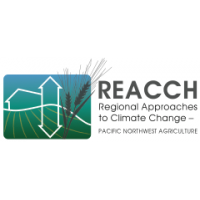Climate variability and anthropogenic climate change present challenges in achieving sustainable agriculture. One of the challenges in maintaining a healthy agroecological system is abundant topsoil and limited soil erosion. In the Inland Northwestern United States temperatures are expected to increase by 1.5-4°C and cool season precipitation is expected to increase 5-10% by the mid-21st century. The sensitivity of soil loss to projected changes in climate was simulated using the Water Erosion Prediction Project (WEPP) model. Sensitivity experiments were performed by running WEPP simulations for a variety of hillslopes and both conventional and no-till cropping practices by altering temperature, precipitation and precipitation extremes from a baseline climate representative of Moscow, Idaho using a continuous winter wheat rotation. Warming experiments enhanced erosion loss through indirect processes such as changes in precipitation phase and soil erodibility. In contrast, precipitation impacted soil loss directly. Projected changes in soil loss were also estimated by forcing WEPP with downscaled climate projections from 20 global climate models (GCM) from the fifth Coupled Model Intercomparison Project for both late 20th century and mid-21st century climate forcings. Increased soil loss rates were simulated by all GCMs for mid-21st century runs compared to late 20th century conditions. These model results suggest increases in soil loss rates under future climate change that will present additional challenges to agricultural sustainability and prompt adaptation practices to conserve soil. The data used to complete this was developed using WEPP with the Palouse soils for the Moscow station. Included in this data set is the directions for how the data is numbered as well as the various ouputs for the analysis. This includes a crop, water, winter, soil, summary, event, pass, and distribution files. Details as to what each of the values within these files represents can be found at http://www.ars.usda.gov/Research/docs.htm?docid=18073. Other files within this dataset include the original slope files used for the analysis, the soil file, management files, and climate files.
The data files associated with this record are no longer actively supported from this repository, please contact original data creator if you need to access these data.
Data and Resources
| Field | Value |
|---|---|
| Modified | 2015-03-31 |
| Release Date | 2015-03-31 |
| Publisher | |
| Identifier | nkn:{FA35A779-54DE-4A54-B26A-C5D4CBACDF27} |
| Spatial / Geographical Coverage Location | -180,-90,180,90 |
| License | Creative Commons Attribution Non-Commercial Share-Alike (CC-BY-NC-SA 4.0) |
| Public Access Level | Public |
| POD Theme | geospatial farming environment geoscientificInformation |
| Harvest Source Title | REACCH PNA |
| Harvest Source URI | http://nknportal.nkn.uidaho.edu/final.json |
| Last Harvest Performed | Fri, 02/01/2019 - 17:30 |

